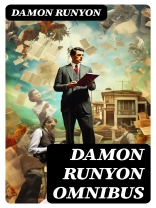The ‘Damon Runyon Omnibus’ is a masterful collection of short stories that encapsulates the vibrant tapestry of New York City’s underworld during the early 20th century. Runyon’s distinctive literary style blends humor with pathos, employing rich, colloquial language that reflects the booming era of Broadway and its colorful characters. His narratives often revolve around gamblers, showgirls, and gangsters, presented with a whimsical twist that elevates the mundane to the extraordinary, while simultaneously commenting on the human condition amidst a backdrop of moral ambiguity and ambition. Damon Runyon (1880-1946) was a significant figure in American literature, renowned for his vivid portrayals of the urban working class. His experiences as a reporter and his affinity for the theatrical world profoundly influenced his storytelling. Raised in a small town, Runyon was drawn to the allure of the city, capturing its essence through meticulously crafted characters and situations that reflect the humor and struggles of life. His unique perspective fosters a connection with readers, inviting them into a world that is both familiar and fantastical. For readers seeking a delightful yet profound exploration of character and culture, the ‘Damon Runyon Omnibus’ is an indispensable addition to any literary collection. With its engaging prose and delightful wit, this anthology not only entertains but also offers a reflective glimpse into the complexities of human nature, making it essential reading for fans of classic American literature.
About the author
Damon Runyon, born Alfred Damon Runyan on October 4, 1880, in Manhattan, Kansas, emerged as a defining voice in American literature, particularly known for his vivid depictions of the New York City demimonde during the early 20th century. Runyon’s storied career began with his early work as a journalist, an experience that profoundly influenced his signature writing style, characterized by a unique blend of humor, wit, and an innovative use of the present tense, as well as his creation of a distinct fictional universe peopled by colorful characters of the Broadway district. His remarkably engaging narratives, often focusing on the lives of gamblers, hustlers, and other denizens of the urban nightlife, greatly contributed to the enduring portrait of New York’s underworld during the Prohibition era. The ‘Damon Runyon Omnibus’, an extensive collection of his short stories, showcases his narrative flair and his astute, often sympathetic, portrayals of marginalized figures, which became a cornerstone of the so-called ‘Runyonesque’ genre. Noteworthy among his celebrated works are stories like ‘Guys and Dolls’, which later inspired the eponymous hit musical. Runyon’s legacy is not merely confined to the printed page, as his stories notably influenced the gangster genre in both literature and cinema. Passing away on December 10, 1946, Runyon left behind a literary legacy that continues to capture the imaginations of readers and remains an indelible part of American cultural heritage.












